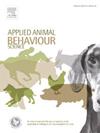圈养动物园环境下黑白皱毛狐猴(Varecia variegata variegata)的行为动态和栖息地利用
IF 2
2区 农林科学
Q1 AGRICULTURE, DAIRY & ANIMAL SCIENCE
引用次数: 0
摘要
黑白皱边狐猴(Varecia variegata variegata)是一种极度濒危的动物,迫切需要在动物园内建立后备种群,提高它们的动物福利和繁殖潜力。然而,研究表明,圈养的巴雷西亚比野生的巴雷西亚更不活跃。目前的研究重点是在爱尔兰科克的Fota野生动物园进行为期一年的研究(2022 - 2022),研究在自然条件下成功繁殖的10只瓦雷西亚的行为模式和栖息地偏好。焦点和扫描取样用于检查时间、日照时间、温度和访客等一系列因素对行为库和活动预算的影响,以帮助阐明哪些因素可能影响行为,从而提高管理选择和繁殖成功率。结果表明,除了更高水平的自我导向(9 %)和附属行为(20 %)外,该圈养组的活动预算与野生组相似。幼鱼的亲和行为比亚成鱼多112 %,而成鱼的不活动时间比幼鱼多60 %。这一群体的行为在一天和一年中都发生了显著变化,随着白天时间的延长,运动显著减少,随着温度的升高,亲密行为减少。圈养瓦雷西亚利用最多的区域是自然岛(39% %)和室外网眼隧道(33% %)。岛屿上的运动明显更高,而隧道中有更多的附属行为。游客数量对所有生境的利用都有显著影响,靠近岛屿和隧道的游客数量越多,隧道的使用就越多,而靠近观景窗的游客数量越多,非展览笼内的利用率就越高。这些数据有助于我们了解Varecia在圈养环境中的行为动态,并可能为提高该物种在复杂动物园环境中的自然行为提供潜在的见解,同时也为未来的畜牧业提供有价值的指导。本文章由计算机程序翻译,如有差异,请以英文原文为准。
Dynamics of behaviour and habitat-use of black-and-white ruffed lemurs (Varecia variegata variegata) in a captive zoo environment
Black-and-white ruffed lemurs (Varecia variegata variegata) are critically endangered animals, which highlights the urgent need to establish backup populations within zoos and promote their animal welfare and breeding potential. However, studies have shown captive Varecia are more inactive than their wild counterparts. The present research focuses on a year-long study (2022–3) of the behavioural patterns and habitat preferences of a successfully breeding captive group of ten Varecia under naturalistic conditions at Fota Wildlife Park, Cork, Ireland. Focal and scan sampling were used to examine the effects of a series of factors such as time, daylight duration, temperature and visitors on the behavioural repertoire and activity budget to help elucidate which factors may influence behaviour and thereby enhance management options and breeding success. The results reveal that the activity budget of this captive Varecia group was similar to that of their wild counterparts, with the exception of a higher level of self-directed (9 %) and affiliative behaviours (20 %). Juveniles engaged in affiliative behaviours 112 % more than subadults, while adults spent 60 % more time being inactive than juveniles. Behaviours of the group changed significantly across the day and also across the year, with locomotion significantly decreasing as daylight hours lengthened and affiliative behaviours decreasing as temperatures rose. The most utilized area of the captive Varecia was the naturalistic island (39 %) and an out-door mesh tunnel (33 %). Locomotion was significantly higher on the island, while the tunnel had greater occurrences of affiliative behaviours. Visitor numbers had a significant influence on the utilization of all habitats, with higher visitor numbers near the island and tunnel increasing the use of the tunnel, while higher visitor numbers near the viewing window prompted greater utilization of this inside off-exhibit cage. These data contribute to our understanding of the dynamics of the behaviour of Varecia in a captive environment and can potentially offer insights into enhancing natural behaviours of this species within complex zoo settings, whilst also providing valuable guidance for future husbandry.
求助全文
通过发布文献求助,成功后即可免费获取论文全文。
去求助
来源期刊

Applied Animal Behaviour Science
农林科学-行为科学
CiteScore
4.40
自引率
21.70%
发文量
191
审稿时长
18.1 weeks
期刊介绍:
This journal publishes relevant information on the behaviour of domesticated and utilized animals.
Topics covered include:
-Behaviour of farm, zoo and laboratory animals in relation to animal management and welfare
-Behaviour of companion animals in relation to behavioural problems, for example, in relation to the training of dogs for different purposes, in relation to behavioural problems
-Studies of the behaviour of wild animals when these studies are relevant from an applied perspective, for example in relation to wildlife management, pest management or nature conservation
-Methodological studies within relevant fields
The principal subjects are farm, companion and laboratory animals, including, of course, poultry. The journal also deals with the following animal subjects:
-Those involved in any farming system, e.g. deer, rabbits and fur-bearing animals
-Those in ANY form of confinement, e.g. zoos, safari parks and other forms of display
-Feral animals, and any animal species which impinge on farming operations, e.g. as causes of loss or damage
-Species used for hunting, recreation etc. may also be considered as acceptable subjects in some instances
-Laboratory animals, if the material relates to their behavioural requirements
 求助内容:
求助内容: 应助结果提醒方式:
应助结果提醒方式:


